As an Amazon Associate, we earn from qualifying purchases with no additional costs for you.
Cutting and slicing an apple may seem like an essential kitchen task, but many people are unsure how to approach this round fruit with a knife. The apple skin is glossy and slippery, which could cause the knife to slip off the apple and cause an injury. Follow our apple-slicing guide to prep your apples safely and efficiently!
A knife is the best tool to cut and slice an apple. Use a good-quality knife to quarter the apple and then slice the apple pieces into the thickness required for your presentation of the apples or the dish you are preparing. The best apple knives have shorter blades for agility and precise slicing.
Many people think that cutting an apple with a knife does not require much skill, but prepping the apple the right way is safer and gives you the ideal apple piece sizes for your dish. The right knife to slice apples is also essential for getting the best and safest results.
If you are interested in checking out the best knife for cutting and slicing apples, we recommend buying a knife made by the Wüsthof company. You can find it by clicking here (Amazon link).

How To Cut And Slice An Apple With A Knife
Each ingredient processed in the kitchen has different characteristics, which require choosing a suitable knife from your collection and slicing the ingredients the right way.
Apples are a fruit that many people are unsure how to slice correctly, safely, and in a way that complements the way the apples will be served or cooked.
Cutting and slicing an apple properly starts with selecting the right knife. Choosing the right knife makes slicing an apple safer and more accurate, allowing you to control the thickness of the final slices.
What Knife Should You Use To Cut An Apple?
Some people think that the biggest knife in the kitchen is the best option for every job, but this logic is flawed, which is why there are many knife types in the kitchen.
Using a too-big knife is cumbersome on more minor ingredients and is likely to slip, causing injury to the knife user.
Using a knife too small for the job results in multiple cuts to get the job done, mutilating the ingredients and affecting presentation.
A chef’s knife is not the appropriate selection for slicing an apple. The blade is too long and tall to make it a safe option for this task.
A utility knife, paring knife, or Japanese petty knife are the best knives to choose from for slicing an apple. These knives are lighter and shorter, making them more agile for cutting and slicing an apple than knives with larger blades.
If you do not have an appropriate knife for slicing apples in your kitchen, we have some recommendations for knives perfect for the task at the end of the article!
Whichever knife you choose to cut your apple, the knife must be sharp. An apple skin can be surprisingly tough, requiring a sharp knife to penetrate the skin without exerting too much pressure on the knife.
Should You Core An Apple Before Slicing?
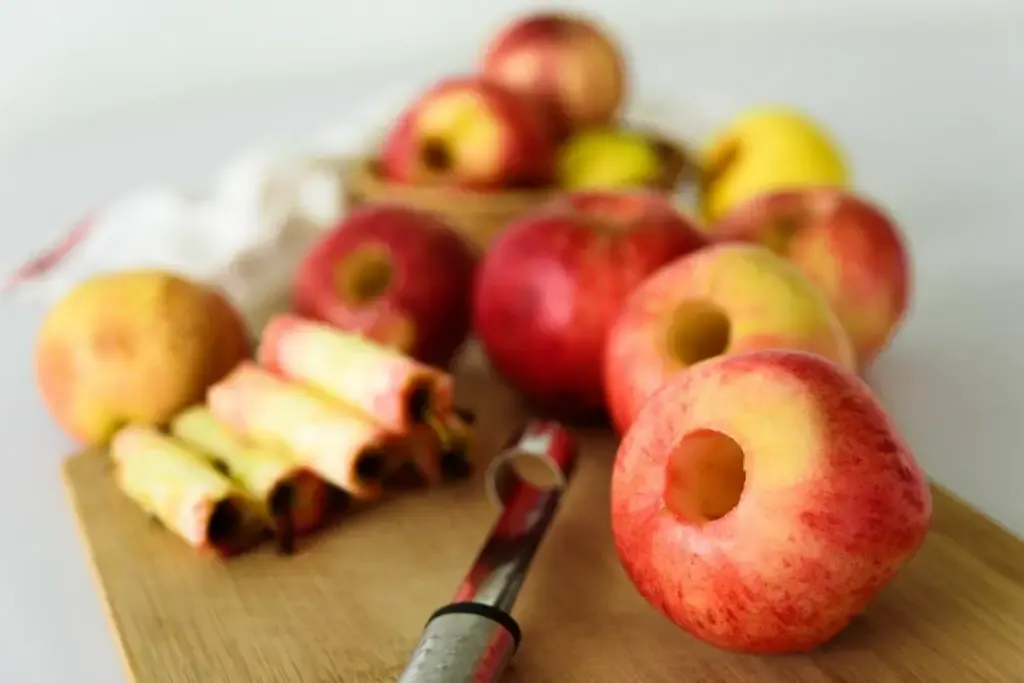
The apple core is the part that should be removed to exclude it from the cooking process or your dish. Apple seeds can be bitter and contain cyanide-like toxins, which you don’t want to feed to your family, friends, or guests.
The toxin levels in apple seeds are usually insufficient to cause harm to people, but it is best to exclude this part of the apple from your cooking.
To avoid slicing the core when cutting your apple, should you remove the core before slicing?
It is not necessary to remove the core before slicing an apple. The cutting techniques we will teach you will avoid the core and leave you with core-free apple pieces ready for eating or slicing for your dish.
It is only necessary to use an apple corer to remove the core if you use the apple whole in a dish, such as whole baked apples.
In this case, the apple will not be sliced but cooked whole. An apple corer (Amazon link) is necessary to remove the core while keeping the rest of the apple intact.
While it is possible to cut and slice an apple when the core has been removed, it is not necessary when using the methods we will explain.
TIP: A Japanese kitchen knife is a precision tool that should not be treated as a multi-purpose utility knife. Find out what items you should never cut with your Japanese knife in the article below:
Complete List: What NOT TO CUT With Japanese Knives & Why?
How To Cut An Uncored Apple
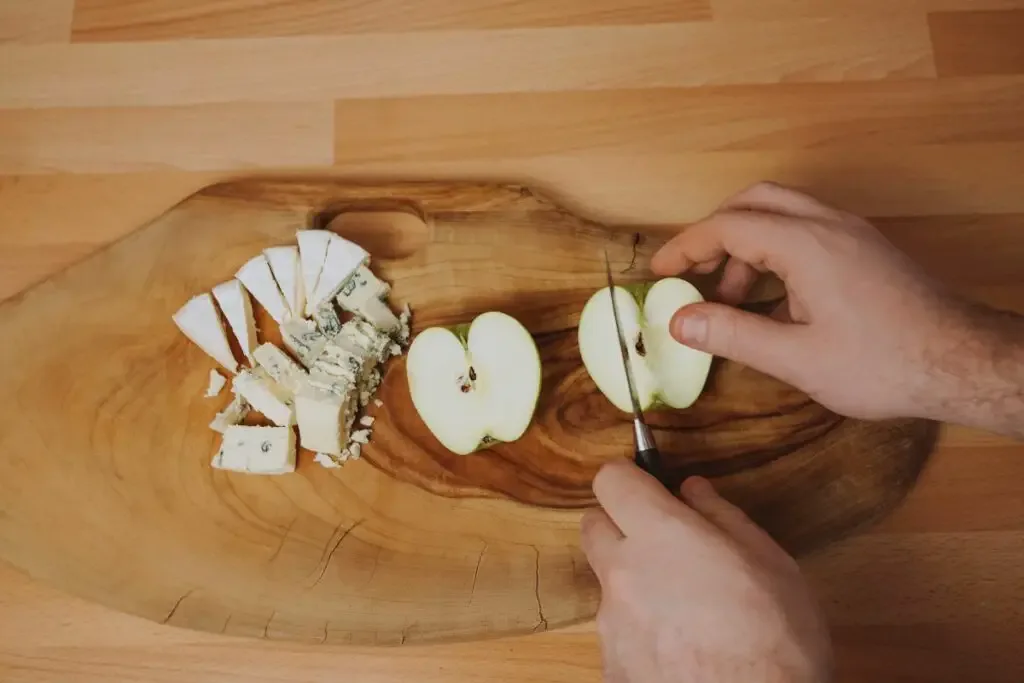
There are kitchen appliances on the market intended to make cutting apples easier. They slice the apple into segments and decore the apple at the same time.
In my experience, these devices end up unused in the kitchen drawer because it is simpler and easier to use a quality knife to do the job.
Cutting and slicing the apple with a knife gives you control over the thickness of the slices and the size of the pieces rather than the cookie-cutter style created by the kitchen appliance.
The Quartering Method To Cut An Apple
Before slicing the apple to the right size for your dish or presentation, cut the apple into chunks and remove the core.
The easiest way to do this is to cut the apple into quarters first and then slice the quarters to the correct size.
To quarter the apple and remove the core, follow these steps.
- Position the apple stalk-side up. Place the apple on the cutting board with the stalk side of the apple (where it was connected to the tree) facing up. The apple should stand on its own in this position, even if it is not entirely straight.
- Support the apple with your free hand. Straighten the apple with your non-knife hand and keep it steady with your fingers away from the section you will cut first.
- Line up the cut. Position the knife’s edge about ½ inch away from the center of the apple. This cutting position will allow you to exclude the core from your cut.
- Make the first cut. Cut the apple by cutting through the skin and continue the cut through the apple to the cutting board. Don’t try to cut through the skin with pressure, but run the knife along the skin to cut through it before continuing the cut through the apple. Using pressure to cut through the skin will slam the knife onto the cutting board and can damage the edge.
- Turn the apple 90° and repeat the cut. Turn the apple 90° and perform the cut again to cut through the next quarter of the apple. Keep the knife the same distance from the apple’s center.
- Repeat the turn and cut another two times. Turn the apple 90° again and cut. Repeat this process until you have four apple pieces on the cutting board and the core remaining as the waste product.
Two pieces of the apple on the cutting board will be bigger than the other two because this method does not cut the apple into exact quarter segments.
If you make an apple sauce, the corners of the core can be trimmed further to get some remaining flesh off the apple core.
The next part of the preparation process is to slice the apple segments into the sizes you need for your dish. Each of the four segments of the apple can be sliced in the same manner.
- Place the apple piece cut side down. Take a cut piece of apple and place it with the cut surface on the cutting board. This position gives a stable cutting platform to slice the piece evenly.
- Determine your slice thickness. Check how thin or thick you need the apple slices for your purpose. Thin slices will cook faster but may also disintegrate during the cooking process. Thicker pieces will take longer to cook but won’t fall apart.
- Slice with the heel of the blade. Us the front part of the blade as a pivot point, and lift the heel of the knife while drawing the knife towards you. To perform the cut, push the knife’s heel down and forward to slice the apple.
- Repeat the slicing for each apple segment. Repeat the slicing for each part of the apple, keeping the slices as even as possible to ensure even cooking.
BTW: If you are interested in buying the best cutting board, you can find our recommendations below:
- The best overall: Virginia Kitchen Boys Cutting Board (Amazon link). This fantastic cutting board is made from sustainable walnut wood from the United States and brings almost perfect safety when cutting with your knives.
- Alternative: Yoshihiro Cutting Board (Amazon link). Professional traditional Japanese cutting board that chefs around the world use.
- Cheaper option: Shun Cultery Cutting Board (Amazon link). Another Japanese cutting board stands out, especially for its simplicity and affordable price.
How Thin Should You Slice An Apple?
The thickness of the apple slices will depend on what you are making with the fruit. Thin, even slices make for an excellent presentation of the raw apple slices on a plate.
Thin slices are also suitable for making apple sauce, where you want the apple pieces to soften and disintegrate into a soft pulp.
If you want the apple slices to stay whole, for example, in an apple pie, they must be thicker to prevent the slices from falling apart when they are cooked.
How To Prevent Sliced Apple From Turning Brown
The best time to cut and slice apples is just before you need to serve them or cook them in the dish you are preparing.
Apple begins to oxidize on the cut surfaces as it reacts with the air, and the apple’s flesh turns brown. This color can be unsightly when the apple is served and detracts from the overall presentation.
One way to avoid this oxidation problem is to cut the apples a few minutes before they are presented or cooked. Another method to prevent browning is to coat the cut surfaces with a bit of fresh lemon juice, which prevents the oxidization process.
Place the apple slices in a bowl with 2 or 3 teaspoons of fresh lemon juice and toss them like a salad to coat all the surfaces with the juice.
TIP: A ceramic knife may be one of the sharpest knives in your kitchen. Find out what to cut and not to cut with a ceramic knife in the article below:
Explained: What To Cut & NOT To Cut With A Ceramic Knife
Best Apple Knife
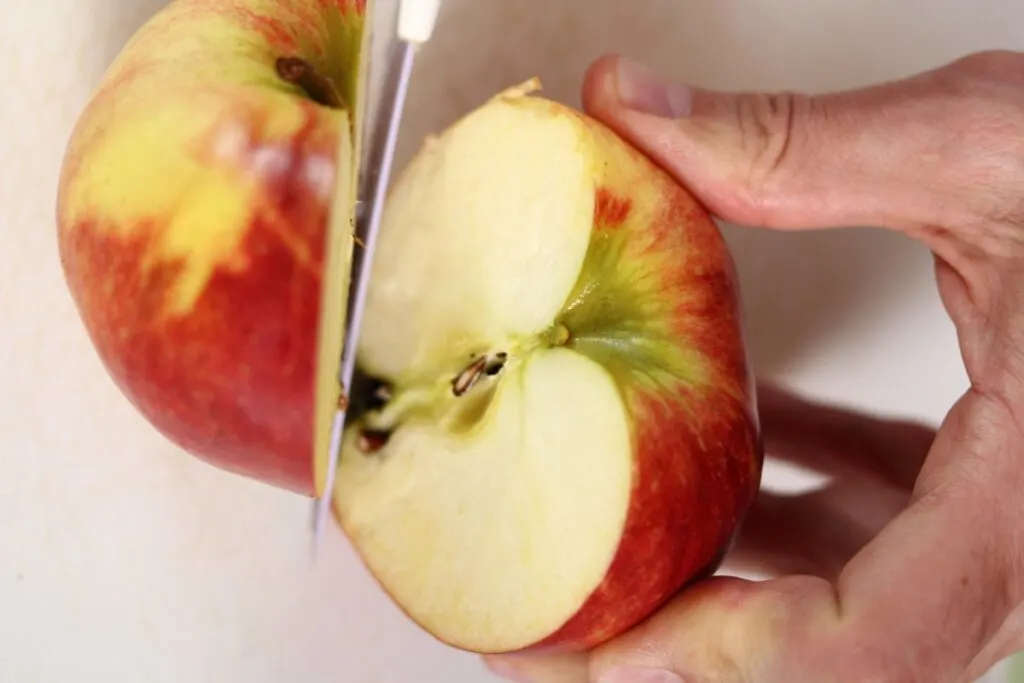
To help you choose the best knife to cut and slice apples, we have selected some knives that we can recommend. These knives are the right size and have a sharp edge capable of producing clean, safe cuts through the apple.
The first knife we recommend as the best apple knife is a paring knife from the well-known German knife manufacturer, Wusthof.
The Wusthof Classic Paring Knife (Amazon link) has a 3.5-inch or 89mm, which provides an agile blade that is easy to maneuver to cut and slice apples.
This knife is made from precision forged stainless steel and created from a single piece of steel to form the blade, integrated bolster, and full tang handle.
The handle scales are made of durable synthetic material, riveted in 3 locations to the full tang handle, creating a secure bond. The full tang design gives the knife excellent balance, contributing to the elegant blade. The Western-style handle is familiar and comfortable.
The blade steel is hardened to 58 on the Rockwell scale, and the edge technology the manufacturer uses produces an extremely sharp knife with excellent edge retention.
Budget Apple Knife
Victorinox is a Swiss knife manufacturer famous for the Swiss Army Knife and its range of top-quality kitchen knives.
Our second recommendation for a good apple knife is the Victorinox Swiss Classic Paring Knife (Amazon link). This paring knife has a 4-inch or 101.6mm blade made from stainless steel.
The blade is slightly longer than the Wusthof paring knife, which is a plus and holds its sharp edge very well. The knife is very lightweight, making it easy to use and perfect for precise cutting and slicing.
The handle design looks a little awkward but fits comfortably in hand and works well with the design of the blade. The handle is not a full tang, contributing to the knife’s lightness. The handle material is a tough polypropylene material that can handle the rigors of the kitchen.
Best Japanese Kitchen Knife To Slice Apples
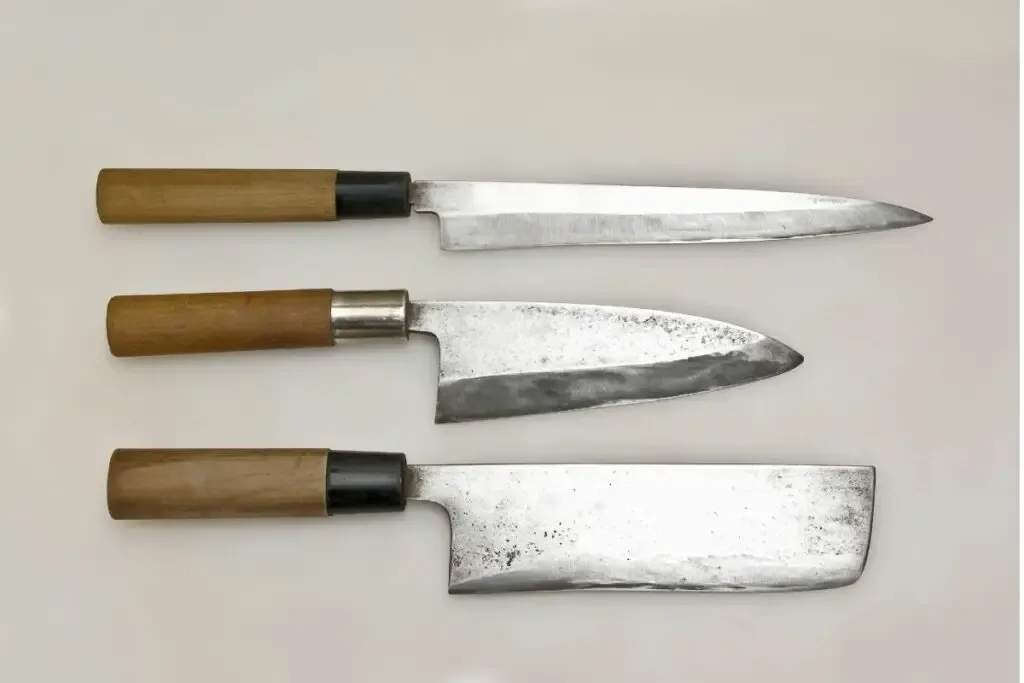
If you have Japanese knives in your kitchen, our next recommended knife to cut and slice apples will fit right in with your knife set!
The Japanese equivalent of a utility knife or paring knife in the kitchen is the petty knife. The Shun Cutlery Classic Utility Knife (Amazon link) is ideal for quick, precise cutting and slicing work in the kitchen, including prep work on your apples.
The VG-MAX stainless steel core is covered with 68 layers of Damascus stainless steel, creating a knife as beautiful as it is sharp!
The D-shaped handle is made from highly durable Pakkawood and is given an ebony finish, contributing to the aesthetics of the knife.
This knife will be an asset in the kitchen and a pleasure to use to prepare your apples and any other vegetable and herb ingredients.
Knife Care and Maintenance
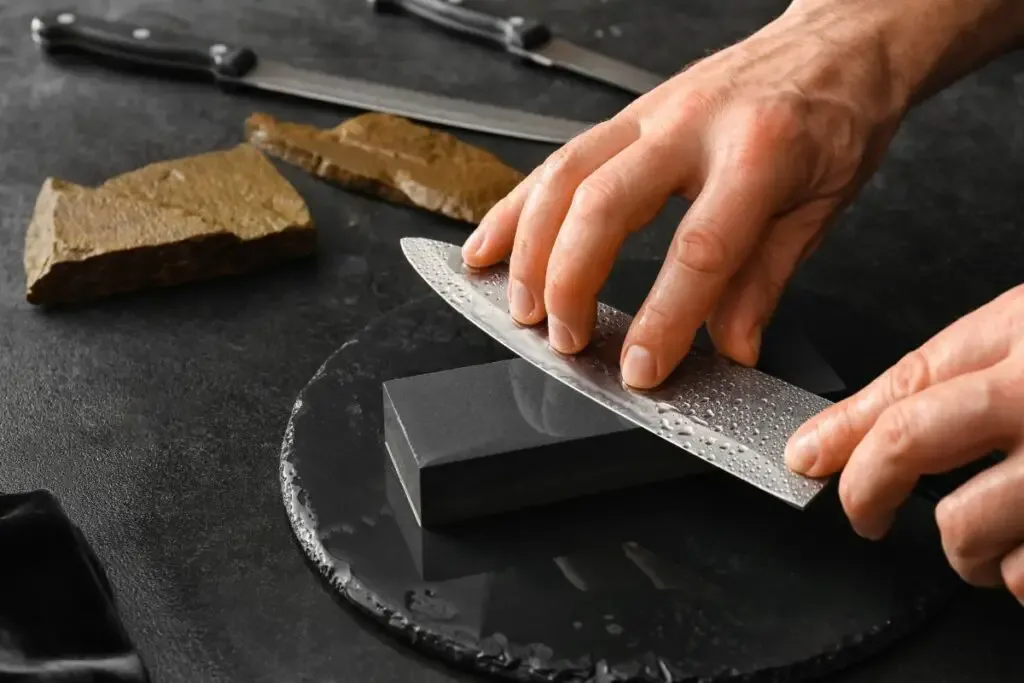
Proper care and maintenance of your knives not only extend their lifespan but also ensure safety and efficiency in your kitchen tasks. Here, we focus on the care and maintenance of knives typically used for cutting apples, such as paring knives, utility knives, and Japanese petty knives.
Sharpening Your Knife
Frequency: Regular sharpening is crucial. For a knife used daily, sharpening every two to three months is recommended. However, this can vary based on usage.
Method: Use a whetstone or a honing rod for sharpening. Start with a coarse grit and move to a finer grit. If you’re not confident in doing this yourself, consider professional sharpening services.
Angle: Maintain the correct angle (usually around 15-20 degrees for most kitchen knives) to ensure an effective edge without compromising the blade’s integrity.
Cleaning Your Knife
Immediate Cleaning: Clean your knife immediately after use. This prevents food acids from damaging the blade.
Hand Wash: Always hand wash your knife with mild dish soap and warm water. Dishwashers can be harsh on knife blades and handles.
Dry Thoroughly: After washing, dry your knife immediately with a soft towel to prevent rust and corrosion.
Storing Your Knife
Knife Block or Magnetic Strip: Store your knives in a knife block or on a magnetic strip. This keeps the blades safe and sharp, as opposed to tossing them in a drawer where they can get damaged.
Avoid Moisture: Store in a dry place. Moisture can lead to rusting of the blade.
Regular Inspection
Check for Damage: Regularly inspect your knife for any signs of wear or damage, such as chips or bends in the blade.
Handle Care: Ensure the handle is secure and intact. Loose or damaged handles can lead to accidents.
Additional Tips
Avoid Cutting on Hard Surfaces: Cutting on glass, stone, or metal can dull your knife quickly. Use a wooden or plastic cutting board instead.
Use the Right Knife for the Right Task: Using your apple-cutting knife for inappropriate tasks (like opening cans or cutting frozen food) can damage the blade.
Oil the Blade: For high carbon steel knives, occasionally oiling the blade can prevent rust.
Remember, a well-maintained knife is a chef’s best friend. Regular care not only keeps your knife in optimal condition but also makes your kitchen tasks more enjoyable and efficient.
Conclusion
Cutting and slicing an apple requires a reliable, sharp knife that does not require excessive pressure to cut through the fruit.
Using the right knife and cutting technique will give you uniform, clean apple slices suitable for presentation in cooked or baked apple dishes!
TIP: If you are looking for Japanese kitchen knives to chop and process vegetables, then you have many you can choose from. Find out the best ones in the article below:
The 8 Best Japanese Knives For Chopping Vegetables
